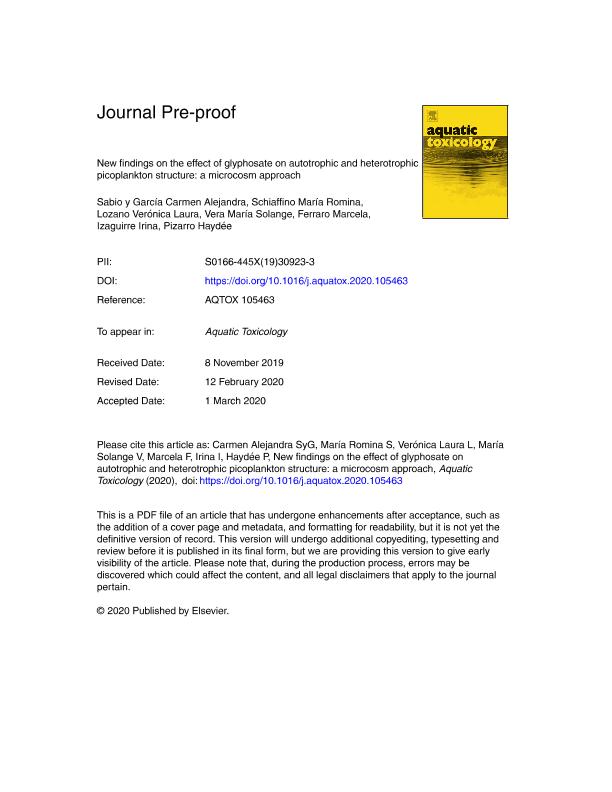Artículo
New findings on the effect of glyphosate on autotrophic and heterotrophic picoplankton structure: A microcosm approach
Sabio y García, Carmen Alejandra ; Schiaffino, María Romina
; Schiaffino, María Romina ; Lozano, Verónica Laura
; Lozano, Verónica Laura ; Vera, Maria Solange
; Vera, Maria Solange ; Ferraro, Marcela Andrea; Izaguirre, Irina
; Ferraro, Marcela Andrea; Izaguirre, Irina ; Pizarro, Haydee Norma
; Pizarro, Haydee Norma
 ; Schiaffino, María Romina
; Schiaffino, María Romina ; Lozano, Verónica Laura
; Lozano, Verónica Laura ; Vera, Maria Solange
; Vera, Maria Solange ; Ferraro, Marcela Andrea; Izaguirre, Irina
; Ferraro, Marcela Andrea; Izaguirre, Irina ; Pizarro, Haydee Norma
; Pizarro, Haydee Norma
Fecha de publicación:
05/2020
Editorial:
Elsevier Science
Revista:
Aquatic Toxicology
ISSN:
0166-445X
Idioma:
Inglés
Tipo de recurso:
Artículo publicado
Clasificación temática:
Resumen
Massive use of glyphosate-based herbicides in agricultural activities has led to the appearance of this herbicide in freshwater systems, which represents a potential threat to these systems and their communities. These herbicides can affect autotrophic and heterotrophic picoplankton abundance. However, little is known about glyphosate impact on the whole structure of these assemblages. Herein, we used an 8-day long microcosm approach under indoor controlled conditions to analyze changes in the structure of picoplankton exposed to a single pulse of glyphosate. The analyzed picoplankton correspond to two outdoor ponds with contrasting states: “clear” (chlorophyll-a = 3.48 μg L−1± 1.15; nephelometric turbidity, NTU = 1) and “turbid” (chlorophyll-a = 105.96 μg L−1 ± 15.3; NTU = 48). We evaluated herbicide impact on different picoplankton cytometric populations and further explored changes in bacterial dominant operational taxonomic units (OTUs) fingerprinting. We observed that glyphosate induced a drastic decrease in the abundance of phycocyanin-rich picocyanobacteria. Particularly, in the turbid system this effect resulted in an 85 % decrease in the abundance of the whole autotrophic picoplankton. Glyphosate also changed the structure of the heterotrophic fraction by means of changing bacterial dominant OTUs fingerprinting patterns in both systems and by shifting the relative abundances of cytometric groups in the clear scenario. These results demonstrate that upon glyphosate exposure picoplanktonic fractions face not only the already reported changes in abundance, but also alterations in the composition of cytometric groups and of bacterial dominant operational taxonomic units. This research provides suitable and still little explored tools to analyze agrochemical effects on picoplanktonic communities.
Palabras clave:
DGGE
,
FLOW CYTOMETRY
,
FRESHWATER ECOSYSTEMS
,
GLYPHOSATE
,
MICROCOSMS
,
PICOPLANKTON
Archivos asociados
Licencia
Identificadores
Colecciones
Articulos(IEGEBA)
Articulos de INSTITUTO DE ECOLOGIA, GENETICA Y EVOLUCION DE BS. AS
Articulos de INSTITUTO DE ECOLOGIA, GENETICA Y EVOLUCION DE BS. AS
Articulos(SEDE CENTRAL)
Articulos de SEDE CENTRAL
Articulos de SEDE CENTRAL
Citación
Sabio y García, Carmen Alejandra; Schiaffino, María Romina; Lozano, Verónica Laura; Vera, Maria Solange; Ferraro, Marcela Andrea; et al.; New findings on the effect of glyphosate on autotrophic and heterotrophic picoplankton structure: A microcosm approach; Elsevier Science; Aquatic Toxicology; 222; 5-2020; 1-40
Compartir
Altmétricas



